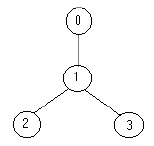poj 1463(树形DP)
Strategic game
| Time Limit: 2000MS | Memory Limit: 10000K | |
| Total Submissions: 7584 | Accepted: 3518 |
Description
Bob enjoys playing computer games, especially strategic games, but sometimes he cannot find the solution fast enough and then he is very sad. Now he has the following problem. He must defend a medieval city, the roads of which form a tree. He has to put the minimum number of soldiers on the nodes so that they can observe all the edges. Can you help him?
Your program should find the minimum number of soldiers that Bob has to put for a given tree.
For example for the tree:

the solution is one soldier ( at the node 1).
Your program should find the minimum number of soldiers that Bob has to put for a given tree.
For example for the tree:

the solution is one soldier ( at the node 1).
Input
The input contains several data sets in text format. Each data set represents a tree with the following description:
The node identifiers are integer numbers between 0 and n-1, for n nodes (0 < n <= 1500);the number_of_roads in each line of input will no more than 10. Every edge appears only once in the input data.
- the number of nodes
- the description of each node in the following format
node_identifier:(number_of_roads) node_identifier1 node_identifier2 ... node_identifiernumber_of_roads
or
node_identifier:(0)
The node identifiers are integer numbers between 0 and n-1, for n nodes (0 < n <= 1500);the number_of_roads in each line of input will no more than 10. Every edge appears only once in the input data.
Output
The
output should be printed on the standard output. For each given input
data set, print one integer number in a single line that gives the
result (the minimum number of soldiers). An example is given in the
following:
Sample Input
4 0:(1) 1 1:(2) 2 3 2:(0) 3:(0) 5 3:(3) 1 4 2 1:(1) 0 2:(0) 0:(0) 4:(0)
Sample Output
1 2
Source
题意:一个游戏有n个点,在某些点上放置哨兵,每个哨兵可以监控和它有边相连的点,问监视所有的点需要的最少的哨兵数.
分析:树形DP,dp[i][0]表示第i个点不放哨兵需要的以i为根节点的子树最少需要的哨兵,dp[i][1]代表第i个点放哨兵需要的以i为根节点的子树最少需要的哨兵
如果某一点不放哨兵,那么他的子节点都需要设一个哨兵。
如果某一点放哨兵,那么就从子节点放还是不放中选最小的.
#include <iostream> #include <stdio.h> #include <string.h> #include <algorithm> #define N 1505 using namespace std; int head[N]; struct Edge{ int u,v,next; }edge[N]; void addEdge(int u,int v,int &k){ edge[k].u = u,edge[k].v = v; edge[k].next = head[u];head[u] = k++; } int dp[N][2]; int indegree[N]; void dfs(int u){ for(int k = head[u];k!=-1;k=edge[k].next){ int v = edge[k].v; dfs(v); dp[u][0]+=dp[v][1]; ///父亲不放,孩子必放 dp[u][1]+=min(dp[v][0],dp[v][1]); ///父亲放了,孩子在放与不放之间选哨兵数小的 } } int main() { int n; while(scanf("%d",&n)!=EOF) { memset(indegree,0,sizeof(indegree)); memset(head,-1,sizeof(head)); int u,v,t; int tot=0; for(int i=0;i<n;i++){ dp[i][0] = 0; dp[i][1] = 1; scanf("%d:(%d)",&u,&t); for(int j=0;j<t;j++){ scanf("%d",&v); addEdge(u,v,tot); indegree[v]++; //printf("%d %d\n",u,v); } } int root; for(int i=0;i<n;i++) if(indegree[i]==0) {root=i;break;} //printf("%d\n",root); dfs(root); printf("%d\n",min(dp[root][0],dp[root][1])); } return 0; }





